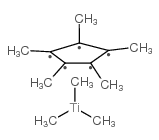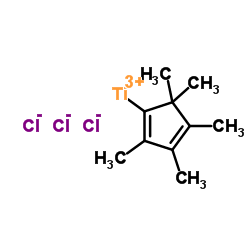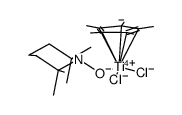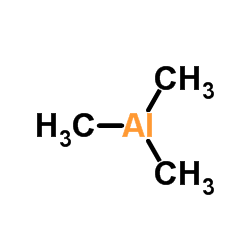(TRICHLOROMETHYL)TRIMETHYLSILANE

(TRICHLOROMETHYL)TRIMETHYLSILANE structure
|
Common Name | (TRICHLOROMETHYL)TRIMETHYLSILANE | ||
|---|---|---|---|---|
| CAS Number | 107333-47-1 | Molecular Weight | 228.19700 | |
| Density | N/A | Boiling Point | N/A | |
| Molecular Formula | C13H24Ti | Melting Point | N/A | |
| MSDS | N/A | Flash Point | N/A | |
| Name | carbanide,cyclopenta-1,3-diene,titanium(4+) |
|---|---|
| Synonym | More Synonyms |
| Molecular Formula | C13H24Ti |
|---|---|
| Molecular Weight | 228.19700 |
| Exact Mass | 228.13600 |
| LogP | 4.72340 |
|
Section 1: Product Identification Chemical Name:(Trimethyl)pentamethylcyclopentadienyltitanium(IV), min. 97% CAS Registry Number:107333-47-1 Formula:(CH3)5C5Ti(CH3)3 EINECS Number:none Chemical Family:metallocene Synonym:Titanium, trimethyl[(1,2,3,4,5-.eta.)-2,4-cyclopentadiene-1-yl]
Section 2: Composition and Information on Ingredients IngredientCAS NumberPercentACGIH (TWA)OSHA (PEL) Title Compound107333-47-1100%no datano data Section 3: Hazards Identification Emergency Overview:May be irritating to skin, eyes and mucous membranes. Primary Routes of Exposure:Ingestion Eye Contact:May cause mild to moderate irritation of the eyes. Skin Contact:May cause slight to mild irritation of the skin. Inhalation:Dust may be irritating to the nose, mucous membranes and respiratory tract. Ingestion:No information is available on the physiological effects of ingestion. Acute Health Affects:May be irritating to skin, eyes and respiratory tract. Chronic Health Affects:No information available on long-term chronic effects. NTP:No IARC:No OSHA:No SECTION 4: First Aid Measures Immediately flush the eyes with copious amounts of water for at least 10-15 minutes. A victim may need Eye Exposure: assistance in keeping their eye lids open. Get immediate medical attention. Wash the affected area with water. Remove contaminated clothes if necessary. Seek medical assistance if Skin Exposure: irritation persists. Remove the victim to fresh air. Closely monitor the victim for signs of respiratory problems, such as difficulty in Inhalation: breathing, coughing, wheezing or pain. In such cases seek immediate medical assistance. Seek medical attention immediately. Keep the victim calm. Give the victim water (only if conscious). Induce Ingestion: vomiting only if directed by medical personnel. SECTION 5: Fire Fighting Measures Flash Point:no data Autoignition Temperature:no data Explosion Limits:no data Extinguishing Medium:carbon dioxide or dry powder If this product is involved in a fire, firefighters should be equipped with NIOSH approved positive pressure Special Fire Fighting Procedures: self-contained breathing apparatus. Hazardous Combustion andIf involved in a fire this product may emit toxic and corrosive fumes. Decomposion Products: Unusual Fire or Explosion Hazards: Flammable solid SECTION 6: Accidental Release Measures Spill and Leak Procedures:Remove sources of ignition. do not raise dust. sweep up the solids and dispose of properly. SECTION 7: Handling and Storage Handle and store the material under an inert atmosphere of nitrogen or argon. Keep away from heat and Handling and Storage: moisture. SECTION 8: Exposure Controls and Personal Protection Eye Protection:Always wear approved safety glasses when handling a chemical substance in the laboratory. Skin Protection:Wear protective clothing and gloves. Ventilation:If possible, handle the material in an efficient fume hood. If ventilation is not available a respirator should be worn. The use of respirators requires a Respiratory Respirator: Protection Program to be in compliance with 29 CFR 1910.134. Ventilation:If possible, handle the material in an efficient fume hood. Additional Protection:No additional protection required. SECTION 9: Physical and Chemical Properties Color and Form:yellow xtl. Molecular Weight:228.22 Melting Point:no data Boiling Point:no data Vapor Pressure:no data Specific Gravity:no data Odor:not determined Solubility in Water:insoluble SECTION 10: Stability and Reactivity Stability:air, light and moisture sensitive. (store cold) Hazardous Polymerization:No hazardous polymerization. Conditions to Avoid:none Incompatibility:oxidizing agents and active metals Decomposition Products:carbon monoxide, carbon dioxide, titanium oxide and organic fumes. SECTION 11: Toxicological Information RTECS Data:No information available in the RTECS files. Carcinogenic Effects:no data Mutagenic Effects:no data Tetratogenic Effects:no data SECTION 12: Ecological Information Ecological Information:No information available SECTION 13: Disposal Considerations Disposal:Dispose of according to local, state and federal regulations. SECTION 14: Transportation Shipping Name (CFR):Flammable solids, Organic, N.O.S. Hazard Class (CFR):4.1 Additional Hazard Class (CFR):NA Packaging Group (CFR):II UN ID Number (CFR):UN# 1325 Shipping Name (IATA):Flammable solid, Organic, N.O.S. Hazard Class (IATA):4.1 Additional Hazard Class (IATA):NA Packaging Group (IATA):II UN ID Number (IATA):UN# 1325 SECTION 15: Regulatory Information TSCA:Not listed in the TSCA inventory. SARA (Title 313):Title compound not listed Second Ingredient:none SECTION 16 - ADDITIONAL INFORMATION N/A |
|
~96% 
(TRICHLOROMETHY... CAS#:107333-47-1 |
| Literature: Mena, Miguel; Royo, Pascual; Serrano, Ricardo; Pellinghelli, Maria Angela; Tiripicchio, Antonio Organometallics, 1989 , vol. 8, p. 476 - 482 |
|
~% 
(TRICHLOROMETHY... CAS#:107333-47-1 |
| Literature: Organometallics, , vol. 23, # 4 p. 836 - 845 |
|
~% 
(TRICHLOROMETHY... CAS#:107333-47-1 |
| Literature: Organometallics, , vol. 28, # 24 p. 6944 - 6956 |
|
~% 
(TRICHLOROMETHY... CAS#:107333-47-1 |
| Literature: Organometallics, , vol. 28, # 24 p. 6944 - 6956 |
| HS Code | 2931900090 |
|---|---|
| Summary | 2931900090. other organo-inorganic compounds. VAT:17.0%. Tax rebate rate:13.0%. Supervision conditions:AB(certificate of inspection for goods inward,certificate of inspection for goods outward). MFN tariff:6.5%. General tariff:30.0% |
| decamethylrhenocene |
| MFCD00269851 |




![[(η5-pentamethylcyclopentadienyl)TiMe((cyclopentyl)7Si7O9(OSiMe3)O2)] structure](https://image.chemsrc.com/caspic/076/1202038-74-1.png)

![[(η5-pentamethylcyclopentadienyl)Ti(O(t-Bu))Me2] structure](https://image.chemsrc.com/caspic/318/154789-31-8.png)